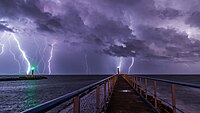
Photo from wikipedia
This article focuses on the bidirectional return-stroke propagation phenomenon in the initiation process of lightning return stroke. Different from the conventional return-stroke model, the return-stroke current waves in the bidirectional… Click to show full abstract
This article focuses on the bidirectional return-stroke propagation phenomenon in the initiation process of lightning return stroke. Different from the conventional return-stroke model, the return-stroke current waves in the bidirectional return-stroke model are considered to propagate simultaneously in both the upward and downward directions at two different speeds from the junction point, where the downward and upward leaders connect with each other. The finite-difference time-domain (FDTD) method in the two-dimensional cylindrical coordinate is employed for the calculation. From the simulation results of the bidirectional return-stroke model, it can be found that compared with the conventional return-stroke model, initial peaks will appear at the rising edges both for the vertical electric field and azimuthal magnetic field at the certain conditions. The influences of characteristic parameters, including the height of junction point, the propagation velocities of downward return strokes, and the ground conductivity, on the computed results are analyzed. To accurately reproduce the radiated electromagnetic fields, the bidirectional propagation model should be taken into consideration.
Journal Title: IEEE Transactions on Electromagnetic Compatibility
Year Published: 2020
Link to full text (if available)
Share on Social Media: Sign Up to like & get
recommendations!